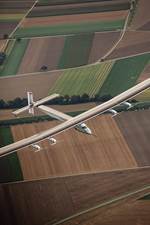Solar-powered flight: Where it all began
A very short history of solar-powered flight.
The story of solar-powered flight began November 1974 when the Sunrise I model airplane flew for 20 minutes at Camp Irwin, Calif. Designed by R.J. Boucher of Astro Flight Inc. (Bicycle Lake Army Airfield, Fort Irwin, Barstow, Calif.) under contract with the Defense Advanced Research Projects Agency (DARPA, Arlington, Va.), Sunrise I was later seriously damaged in flight by a sudden sandstorm. Sunrise II took flight in September 1975, but also was damaged, in this case, due to failure in the control system. Not quite a year later, in Germany, Fred Militky flew a solar-powered model, Solaris, in three flights of longer than two minutes each. Visions of manned solar flight weren’t realized until May 1980, when Dr. Paul McCready of AeroVironment Inc. (Monrovia, Calif.) flew the Gossamer Penguin in the world’s first piloted, solar-powered flight.
In 2001, Helios, an unmanned solar-powered aircraft, developed by AeroVironment and NASA's Dryden Flight Research Center (Edwards AFB, Calif.), reached an unofficial world-record altitude of 96,863 ft/29,524m, sustaining flight above 96,000 ft/29,261m for more than 40 minutes, during a test flight near Hawaii. Unfortunately, the aircraft broke apart during a flight in June 2003 over Kauai, Hawaii, when it encountered unexpected air turbulence, and was lost into the Pacific Ocean.
In 2010, Solar Impulse 1 was the first solar powered aircraft to fly all night, with a pilot onboard.
This short article is a sidebar to a feature article titled "Spread-tow technology takes off." To read the main article, click on its title under "Editor's Picks," at top right.
Related Content
-
Plant tour: Albany Engineered Composites, Rochester, N.H., U.S.
Efficient, high-quality, well-controlled composites manufacturing at volume is the mantra for this 3D weaving specialist.
-
Combining multifunctional thermoplastic composites, additive manufacturing for next-gen airframe structures
The DOMMINIO project combines AFP with 3D printed gyroid cores, embedded SHM sensors and smart materials for induction-driven disassembly of parts at end of life.
-
Composites manufacturing for general aviation aircraft
General aviation, certified and experimental, has increasingly embraced composites over the decades, a path further driven by leveraged innovation in materials and processes and the evolving AAM market.












